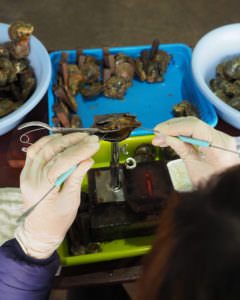Tahitian pearl harvesting is a fascinating and intricate process, characterized by its uniqueness and rarity. Tahitian pearl farms, unlike their larger-scale counterparts, are small in scale, primarily due to the scarcity of their star player, the black lip oyster. In this comprehensive guide, we will delve into the mesmerizing world of Tahitian pearl farming, exploring the natural habitats, harvesting techniques, and the delicate art of nucleation. Join us as we uncover the hidden secrets of these prized gems.
The Natural Habitat of Black Lip Oysters
Oysters, including the black lip variety, are naturally inhabitants of lagoons, where they thrive and mature. Tahitian pearl farms are essentially collections of these lagoons, each carefully nurtured to support the growth of black lip oysters. Harvesting pearls from these farms is an intriguing process that involves human intervention to yield authentically harvested pearls.
The Essence of the Lagoons

Tahitian pearl farms consist of several lagoons, mimicking the oysters’ natural habitat. These lagoons serve as the nurturing ground for the black lip oysters, allowing them to grow and mature.
The Harvesting Process
The process of harvesting Tahitian pearls begins with carefully extracting the lagoons from the water, transporting them to specialized harvesting facilities. This crucial step ensures the authenticity of the pearls produced. At the facility, the skilled pearl farmer expertly pries apart the shells of the black lip oysters to expose the hidden treasures within.
The Precise Art of Tahitian Pearl Harvesting
Each pearl is removed with precision, employing a set of specialized tools that are designed to protect the oysters from harm. These tools not only facilitate the gentle extraction of the pearl but also ensure that it emerges unscathed, without any breakages or damage.
Tools of the Trade
The tools used in the harvesting process are of paramount importance. They are designed to allow the pearl farmers to remove the pearl with utmost care, safeguarding the oyster’s well-being. These tools have evolved over time to become integral in the delicate art of pearl harvesting.
Minimizing Impact
One of the primary goals of Tahitian pearl harvesting is to minimize any negative impact on the oysters. Ensuring that the oysters are not injured or killed during the process is not only ethical but also crucial for sustaining the industry.
The Nucleation Process: Creating Cultured Pearls

The nucleation process is the key to cultivating cultured pearls. This intricate procedure involves stimulating the production of nacre by introducing a foreign object into the oyster. In response to this irritant, the oyster produces layer upon layer of nacre until a pearl is formed.
Survival of the Fittest
During the initial nucleation process, only a select few oysters survive. These survivors are the strong ones and can be nucleated repeatedly. In fact, a black lip oyster can undergo nucleation up to five times before it must be discarded.
The Unique Mabe Pearls
The last nucleation process an oyster undergoes results in the creation of mabe pearls, often referred to as blister pearls. These cultured pearls develop inside the inner shell of the black lip oyster rather than within its body. Mabe pearls typically exhibit a half-spherical shape, adding to their distinctiveness.
The Timing of Tahitian Pearl Harvesting
Tahitian pearl harvesting primarily occurs between the months of May and November. It is a time when the pearl farmers are not only engaged in harvesting the pearls but also nucleating the oysters for future production. During the harvest, a precise incision is made in the gonad of the oyster, allowing for the careful removal of the pearl.
Environmental Sustainability
Tahitian pearl farms are increasingly focusing on environmental sustainability. These farms understand the importance of preserving the delicate ecosystems in which black lip oysters thrive. Implementing responsible farming practices is a vital step towards ensuring the longevity of this industry.
The Allure of Tahitian Pearls
Tahitian pearls are renowned for their remarkable beauty and unique allure. Their exquisite colors, ranging from deep black to peacock green, combined with their organic origins, make them a sought-after choice in the world of pearl jewelry. The intricate process of harvesting these pearls only enhances their desirability.
Conclusion
The world of Tahitian pearl farms and the art of harvesting these exquisite gems is a captivating journey. From the natural habitats of black lip oysters to the meticulous extraction of pearls and the fascinating nucleation process, this industry is a blend of science, art, and nature. Tahitian pearls continue to hold a special place in the hearts of jewelry enthusiasts and collectors worldwide, as they represent the unique and alluring beauty that emerges from the depths of pristine Tahitian waters.
Tahitian pearl farming is unique due to its scale and the star player, the black lip oyster. Unlike many other pearl farms, Tahitian pearl farms are smaller in scale because black lip oysters are relatively scarce. The farming process is meticulous, emphasizing the well-being of the oysters to produce authentic pearls. The process also takes place in lagoons that mimic the oysters’ natural habitat.
The nucleation process in Tahitian pearl farming involves the introduction of a foreign object into the black lip oyster. This irritates the oyster, causing it to coat the irritant with layers of nacre, which eventually leads to the formation of a pearl. It’s a delicate procedure, and during the initial nucleation, only a few oysters survive. These survivors can be nucleated multiple times, with the last nucleation producing mabe pearls, which develop inside the oyster’s inner shell.
Environmental sustainability is an important focus in Tahitian pearl farming. These farms recognize the need to protect the ecosystems where black lip oysters thrive. To ensure the longevity of the industry, responsible farming practices are implemented. This includes efforts to minimize the environmental impact of harvesting and cultivation, and it’s becoming an increasingly integral part of the Tahitian pearl industry.

